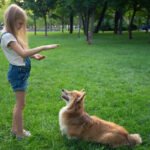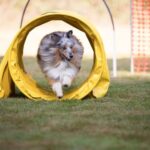Have you ever wondered how to train your dog to find treats? Training your furry friend to use their sense of smell is not only a fun activity, but it also provides mental stimulation and can strengthen the bond between you and your pet. In this article, we will explore the basics of scent training, the importance of mental stimulation for dogs, and provide a step-by-step guide on how to teach your dog the “find it” command.
Dogs thrive on mental stimulation, and scent training is a great way to engage their natural instincts. Not only does it provide a mental workout, but it also offers a rewarding bonding experience for both you and your canine companion. By understanding the basics of scent training and choosing the right treats for training, you can create an enjoyable and enriching experience for your dog.
In the following sections, we will delve into the fundamentals of scent training and outline a step-by-step guide to teaching your dog the “find it” command. We will also explore how games and challenges can be used to enhance scent training, address common issues that may arise during training, and offer advanced techniques for those who want to take their dog’s newfound skill to the next level.
So let’s get started on this exciting journey of training your dog to find treats.
Understanding the Basics of Scent Training
Scent training is an effective way to mentally stimulate your dog and can also be a fun activity for both of you. In this section, we will discuss the basics of scent training and how it works. Dogs have an incredible sense of smell, and scent training taps into this natural ability. By engaging in scent work, your dog can build confidence, decrease anxiety, and improve focus.
The first step in understanding scent training is to recognize that dogs use their noses to explore and understand the world around them. Scent work involves teaching your dog to identify and locate specific scents.
This type of training is often used in search and rescue operations, as well as in competitive sports such as nose work or tracking. Scent training can also be beneficial for pet dogs as it provides mental stimulation and helps strengthen the bond between you and your furry friend.
To start scent training with your dog, you’ll want to begin with a specific scent that they can easily recognize. This could be a treat or a favorite toy. As your dog becomes more proficient at identifying this initial scent, you can gradually introduce different scents for them to learn.
It’s important to keep training sessions short and positive to prevent your dog from becoming frustrated or disinterested. With patience and consistency, you’ll be amazed at how quickly your dog can progress in their scent training abilities.
Choosing the Right Treats for Training
When it comes to training your dog to find treats, choosing the right treats is essential for successful scent training. It’s important to select treats that are not only irresistible to your dog but also have a strong and distinct smell that will help your dog in finding them.
Consider the Smell and Size
When choosing treats for scent training, opt for ones that have a strong and appealing smell. This will make it easier for your dog to detect the scent and ultimately find the treat. Additionally, consider the size of the treats – they should be small enough for your dog to consume quickly but big enough for them to detect easily.
Avoid High Calorie Treats
While it’s important for the treats to be enticing, it’s also crucial to avoid high-calorie options. Since you’ll be using these treats frequently during training, you don’t want to risk overfeeding your furry friend. Look for low-calorie options or simply cut regular treats into smaller pieces.
Experiment With Different Textures
Another factor to consider when choosing treats for scent training is the texture. Some dogs may respond better to crunchy treats, while others may prefer soft and chewy ones. Experiment with different textures to see what your dog responds best to and adjust accordingly.
By carefully selecting the right treats for scent training, you’ll set your dog up for success and make the training process more enjoyable and rewarding for both of you.
Establishing a Positive Association With the Scent
Dogs have an incredible sense of smell, and they can be trained to use this skill to find treats or other objects. Establishing a positive association with the scent is an essential part of training your dog to find treats. This involves creating a strong connection in your dog’s mind between the specific scent you want them to find and the reward they will receive for finding it.
To establish a positive association with the scent, follow these simple steps:
- Choose a high-value treat that your dog loves. This could be small pieces of cooked chicken, cheese, or any other tasty morsel that your dog finds irresistible.
- Introduce the treat to your dog and allow them to sniff it so they become familiar with its scent.
- Once your dog shows interest in the treat, give it to them immediately. This will reinforce the positive association between the scent and the reward.
It’s important to repeat this process several times until your dog consistently shows excitement when they smell the treat. Building a strong positive association with the scent will lay the groundwork for successful scent training. Once this association is established, you can move on to teaching your dog specific commands to find treats using their sense of smell.
Step-by-Step Guide to Teaching Your Dog the Find It Command
Training your dog to find treats can be a fun and rewarding activity for both you and your furry friend. Teaching your dog the “find it” command can provide mental stimulation and enrichment, as well as strengthen the bond between you and your pet. Follow these steps to start training your dog in the find it command:
- Choose a quiet place with minimal distractions to begin training.
- Show your dog a treat and allow them to sniff it, then place it on the ground a short distance away from them.
- Encourage your dog to find the treat by using the verbal cue “find it” or any other word of your choice.
- As soon as your dog locates the treat, praise them enthusiastically and offer additional treats or play as a reward.
Consistency is key when teaching your dog the find it command. Practice this exercise regularly, gradually increasing the difficulty by placing treats in different locations within the training area. Be patient with your dog as they learn this new skill, and always make sure that training sessions are positive and enjoyable for them.
By following these steps, you can help your dog develop their natural scenting abilities while also providing them with mental stimulation and physical activity. The find it command is not only a fun game to play with your dog but also an important skill that can be useful in various situations, such as finding hidden objects or even search-and-rescue activities.
Using Games and Challenges to Enhance Scent Training
Once your dog has mastered the basics of scent training and the “find it” command, you can further enhance their skills by incorporating games and challenges into their training routine. These activities not only provide mental stimulation but also make the training process more enjoyable for both you and your furry friend.
One popular game to play with your dog is the “shell game” where you place a treat under one of three cups or containers and mix them up. Then, encourage your dog to find the cup with the treat underneath. This game helps improve their memory and problem-solving skills while honing their ability to follow a specific scent.
Another fun challenge is setting up a scavenger hunt for your dog using their favorite toys or treats as targets. Hide the items in different locations around the house or yard, and then give your dog the command to search for each item. Not only does this activity strengthen their scent detection abilities, but it also encourages physical activity as they move around to locate each hidden treasure.
Furthermore, consider introducing your dog to novel scents by incorporating essential oils or herbs into their training regimen. You can use containers with holes for them to sniff out the source of the scent or place drops on different items for them to locate. Gradually increasing the difficulty of identifying various scents will help keep their senses sharp and engaged in the training process.
| Games and Challenges | Description |
|---|---|
| Shell Game | A game where a treat is placed under one of three cups, mixed up, and your dog must find which cup contains the treat. |
| Scavenger Hunt | Hiding toys or treats in different locations around the house or yard for your dog to search for. |
| Introducing New Scents | Incorporating essential oils or herbs into training by using containers with holes or placing drops on different items for dogs to locate. |
Troubleshooting
Lack of Interest in the Scent
If your dog seems uninterested in finding treats during scent training, it could be due to a few reasons. One common issue is that the treats you are using may not have a strong enough scent to capture your dog’s attention. In this case, try using treats with a stronger aroma, such as freeze-dried liver or cheese.
Additionally, your dog may simply need more time and patience to understand the concept of the game. Be sure to use high-value rewards and plenty of praise when they do show interest in the scent.
Difficulty Finding Treats
Some dogs may struggle with actually locating the treats during scent training. If this is the case, consider starting with easier hiding spots and gradually increasing difficulty as your dog becomes more proficient.
You can also try using a larger quantity of treats initially to make it easier for your dog to succeed. Another helpful tip is to use a consistent phrase or command when instructing your dog to search for the treats, which can help them understand what is expected of them.
Overexcitement or Impatience
It’s common for dogs to become overexcited or impatient during scent training, especially if they are eager to find the treats. To address this issue, work on reinforcing calm behavior and impulse control through other forms of training before returning to scent work.
Additionally, taking short breaks during sessions can help prevent frustration and keep your dog focused. Finally, be mindful of your own energy; remaining calm and patient will help set a positive tone for your dog during training sessions.
Taking Scent Training to the Next Level
Now that your dog has mastered the basics of scent training and can reliably find treats, it’s time to take their skills to the next level. One advanced technique is teaching your dog to discriminate between different scents. This can be achieved by introducing multiple scents and rewarding your dog for finding the specific scent you’re targeting. This type of training can be particularly useful for activities like search and rescue or detection work.
Another advanced technique involves increasing the difficulty of the hiding spots for the treats. Start by hiding treats in more challenging locations, such as high on a shelf or under a piece of furniture. As your dog becomes more skilled at finding treats, you can introduce outdoor scent training, creating new and exciting challenges for them.
It’s also important to continue to vary the types of treats you use during scent training. This not only keeps your dog engaged and excited about the game, but it also helps them learn to recognize different scents more effectively. Consider using a variety of textures, flavors, and smells in your treat selection to keep things interesting for your furry friend.
| Advanced Techniques | Tips |
|---|---|
| Teaching discrimination between scents | Rewarding with different scents |
| Increasing difficulty of hiding spots | Introduce outdoor scent training |
| Varying types of treats | Using a variety of textures, flavors, and smells |
Conclusion
In conclusion, training your dog to find treats is not only a great way to provide mental stimulation, but it also strengthens the bond between you and your furry friend. Throughout this process, you have learned about the basics of scent training, the importance of choosing the right treats, and how to establish a positive association with the scent.
By following the step-by-step guide and using games and challenges, you have successfully taught your dog the “find it” command.
As you continue to practice scent training with your dog, it’s important to remember that troubleshooting common issues is part of the process. Whether your dog becomes easily distracted or struggles to understand the command, patience and consistency will be key in overcoming these challenges. Additionally, as you progress with scent training, consider taking it to the next level by exploring advanced techniques and tips for an even more enriching experience for both you and your dog.
Overall, celebrating your dog’s newfound skill in finding treats is a momentous achievement. Not only have you provided mental stimulation for your pet, but you have also strengthened your bond through this shared activity. As you continue exploring different ways to engage with your dog, consider other forms of training and activities that further foster this bond. With dedication and love, both you and your furry companion will continue to grow together on this incredible journey.
Frequently Asked Questions
How Do I Train My Dog to Search for Treats?
Training your dog to search for treats can be a fun and rewarding experience for both you and your pet. Start by teaching your dog the “search” or “find it” command, and hiding treats in easy-to-find locations. Gradually increase the difficulty by hiding treats in more challenging spots.
Use positive reinforcement, like praise and treats, when your dog successfully finds the hidden treats. Over time, your dog will learn to search for treats on command.
How Do I Train My Dog to Catch Treats?
To train your dog to catch treats, start with small, soft treats that are easy for your dog to catch in their mouth. Stand close to your dog and gently toss the treat towards them – this will make it easier for them to catch it at first. As your dog gets better at catching treats, increase the distance between you and them.
Be patient and persistent, using positive reinforcement when they successfully catch a treat. With practice, your dog will become an expert at catching treats.
How Do I Train My Dog to Find Things?
Teaching your dog to find things can be a useful skill, whether you want them to locate their favorite toy or help you find lost items around the house. Start by using a familiar item that your dog enjoys, like a favorite toy or treat. Show it to them, then hide it in an easy-to-find spot at first. Encourage your dog to search for the item using verbal cues like “find it” or “search.”
When they successfully locate the item, reward them with praise and a treat. Gradually increase the difficulty of the hiding spots as your dog becomes more proficient at finding things. With consistent training and positive reinforcement, your dog will master this skill in no time.

Welcome to the blog! I am a professional dog trainer and have been working with dogs for many years. In this blog, I will be discussing various topics related to dog training, including tips, tricks, and advice. I hope you find this information helpful and informative. Thanks for reading!





